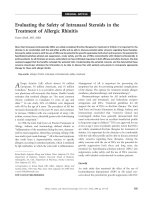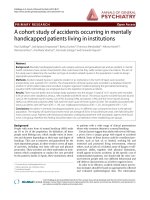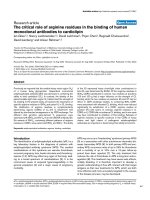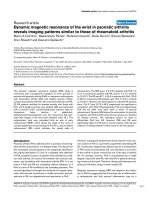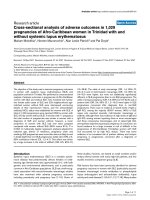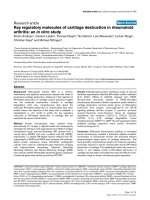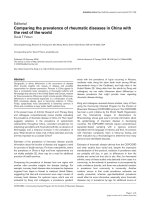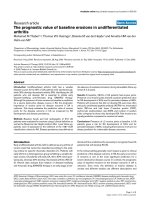Báo cáo y học: "Psychophysiology and psychoacoustics of music: Perception of complex sound in normal subjects and psychiatric patients" docx
Bạn đang xem bản rút gọn của tài liệu. Xem và tải ngay bản đầy đủ của tài liệu tại đây (210.62 KB, 4 trang )
BioMed Central
Page 1 of 4
(page number not for citation purposes)
Annals of General Hospital
Psychiatry
Open Access
Review
Psychophysiology and psychoacoustics of music: Perception of
complex sound in normal subjects and psychiatric patients
Stefanos A Iakovides, Vassiliki TH Iliadou*, Vassiliki TH Bizeli,
Stergios G Kaprinis, Konstantinos N Fountoulakis and George S Kaprinis
Address: 3rd Department of Psychiatry, Neuroscience Division, Aristotle University of Thessaloniki, AHEPA University Hospital, Thessaloniki,
Greece
Email: Stefanos A Iakovides - ; Vassiliki TH Iliadou* - ;
Vassiliki TH Bizeli - ; Stergios G Kaprinis - ; Konstantinos N Fountoulakis - ;
George S Kaprinis -
* Corresponding author
Abstract
Perception of complex sound is a process carried out in everyday life situations and contributes in
the way one perceives reality. Attempting to explain sound perception and how it affects human
beings is complicated. Physics of simple sound can be described as a function of frequency,
amplitude and phase. Psychology of sound, also termed psychoacoustics, has its own distinct
elements of pitch, intensity and tibre. An interconnection exists between physics and psychology
of hearing.
Music being a complex sound contributes to communication and conveys information with
semantic and emotional elements. These elements indicate the involvement of the central nervous
system through processes of integration and interpretation together with peripheral auditory
processing.
Effects of sound and music in human psychology and physiology are complicated. Psychological
influences of listening to different types of music are based on the different characteristics of basic
musical sounds. Attempting to explain music perception can be simpler if music is broken down to
its basic auditory signals. Perception of auditory signals is analyzed by the science of
psychoacoustics. Differences in complex sound perception have been found between normal
subjects and psychiatric patients and between different types of psychopathologies.
Review
Perception of complex sound is a process carried out in
everyday life situations and contributes in the way one
perceives reality. Both nature sounds and sounds in most
everyday situations are complex sounds composed of
basic sounds. Basic sounds are most often produced and
heard in laboratory situations. Attempting to explain
sound perception is complicated. Sound has a physical
and a psychological component. Physics of sound has its
origin in the pressure changes as a result of the vibration
of an object. Such changes are perceived by the human
outer ear, propagated and amplified through the ossicles
of the middle ear and the area difference between the tym-
panic membrane and the oval window. Psychology of
sound is based on the perception of its characteristics. It
starts in the motion of the basilar membrane in the coch-
Published: 29 March 2004
Annals of General Hospital Psychiatry 2004, 3:6
Received: 15 December 2003
Accepted: 29 March 2004
This article is available from: />© 2004 Iakovides et al; licensee BioMed Central Ltd. This is an Open Access article: verbatim copying and redistribution of this article are permitted in all
media for any purpose, provided this notice is preserved along with the article's original URL.
Annals of General Hospital Psychiatry 2004, 3 />Page 2 of 4
(page number not for citation purposes)
lea of the inner ear and proceeds to the cochlear nuclei
and to the central auditory pathway to reach both hemi-
spheres of the human brain.
Physics of simple sound can be described as a function of
frequency, amplitude and phase. Complex sounds accord-
ing to Fourier analysis can be broken down into a series of
simple sounds. The frequency components of the com-
plex sound are known as harmonics. Psychology of sound
seems to correspond to the analysis of sound according to
Fourier. Psychology of sound, also termed psychoacous-
tics, has its own distinct elements of pitch, intensity and
tibre. Perception of sound and music is such that humans
are able under certain circumstances to distinguish the
harmonics of a complex periodic sound wave. The hearing
sense provides human beings with data concerning their
environment.
An interconnection exists between physics and psychol-
ogy of hearing. Blowing of the wind, sea waves, birds sing-
ing are more than audible sounds; they have the ability to
interact with the emotions and mood of a human being
and create feelings. Music is the human effort to express
emotions. It has the ability to influence mood, to remind
us of a certain moment, to create feelings. Music contrib-
utes to communication and conveys information with
semantic and emotional elements. These elements indi-
cate the involvement of the central nervous system
through processes of integration and interpretation
together with the peripheral auditory processing [1].
In order to study music perception and the way it influ-
ences human beings, different approaches have been used
involving the types of music, the emotional experience,
psychosomatic and physiological changes and psychoa-
coustical characteristics of music. In certain cases music
has been thought to enhance brain functioning [2]. Data
evaluation reveals the fact that listening to a Mozart's
Sonata for two pianos in D major (K448) lead (according
to one study at least), to a subsequent enhancement in
spatial-temporal reasoning. However other researchers
have investigated the effect with conflicting outcomes [3-
5]. The above results highlight the difficulty of compre-
hending music influences in human brain, particularly
since it is composed of complex sounds.
The way music changes blood pressure and heart rate was
investigated by several studies with different results. There
are studies showing increased heart rates as a result of
stimulating music and decreased heart rates associated
with sedative music [6,7]. Other studies document
increased heart rate as the result of listening to sedative
and stimulating music [8] and Shatin [9] notes an increase
in long term schizophrenics. Gerra et al [10] found that
the type of music can influence heart rate and stress-
related hormones. Specifically Techno-music seemed to
produce a significant increase in heart rate, systolic blood
pressure and stress-related hormones. Classical music pro-
duced no significant changes in these parameters.
Psychophysiological reactions in students due to exposure
to a distorted sound of 400 Hz frequency, 109 db intensity
and 0.5 sec duration are documented as follows [11].
Systolic and diastolic blood pressure were increased 4–11
seconds after the intense auditory stimulus. Afterwards
blood pressure was decreased and reached the normal
level a minute after. This study shows a temporarily
increased blood pressure.
An interesting study documents the psychological and
physiological effects of sound [12]. Monitoring of the sub-
jective perception and the heart and respiratory rate took
place during three different sound conditions, the first
source being a synthesizer, the second bird twitters and
the third mechanical sounds. Inhibition of the parasym-
pathetic nervous system as a result of listening to mechan-
ical sounds was documented together with promoting an
unpleasant and alert feeling. This study suggests that the
heart rate variability changes according to subjective per-
ception.
Loudness and annoyance are two subjective parameters
that can be influenced by age, personal preferences, previ-
ous musical studies and exposure to different kinds of
musical pieces. Two studies by Fucci et al [13,14] are con-
cerned with the preference of loudness for rock music. It
seems obvious that a sound distorted with noise produces
unpleasant feelings. Judging the annoyance of a musical
piece produces different results than judging its loudness.
Annoyance scale appears to be more context-dependent.
Listening to music can be emotionally arousing. Disclos-
ing personal information is beneficial both from a physi-
ologic and physical point of view. Jensen [15] examined
the effect of music in 85 students within a disclosure set-
ting. The study involved speaking of the most significant
event of the subject's life with and without background
music. The results confirmed the effect of music on the
disclosure topics, enhanced cognitive expression and
enjoyment of classical music.
Emotional experience due to music exposure is difficult to
evaluate and study in a systematic way. In a well-organ-
ized work [16] 50 normal hearing persons with no special
interest in music were studied. Their task was to rate each
of the 13 pieces of newly composed music according to 20
semantic scales. Differences in emotional experience have
been documented between women and men, with
women experiencing more tension in music and between
Annals of General Hospital Psychiatry 2004, 3 />Page 3 of 4
(page number not for citation purposes)
different age groups and with older people experiencing
more attraction to music than younger ones.
Psychiatric patients may experience music differently than
normal subjects and this fact can be helpful in monitoring
hearing perception in the different psychopathologies. In
a comparison of normal subjects and psychiatric patients
[17] music was experienced in the same way with only
small differences. However, when evaluating each psychi-
atric group independently several differences were dem-
onstrated. Schizophrenic patients may experience music
as more attractive than normal subjects. Depressive and
anxiety neurotics experience music as less attractive than
normal subjects. Obsessive compulsive patients are more
sensitive to music than normal subjects. In a different
study by the same researchers [18], a comparison of two
pieces of music with different tempo, slow and fast,
revealed a difference in experiencing of music between
normal subjects and patients with mania. Patients with
mania associated fast tempo with positive emotions and
declared attraction to it, with the control group having the
same emotions with slow tempo music.
In an interesting and well-designed study on the percep-
tion of complex sound in schizophrenia and mania [19];
complex nonverbal sounds with 3 s duration were used.
They were used instead of music as they are more simple
to analyze. They were chosen to represent variation in fre-
quency, amplitude spectrum and envelope. The patients
were selected from a ward department with classification
according to ICD 9. Testing was performed no later than 1
week after admission as a general rule. The main result of
the study was that short complex sounds give rise to dif-
ferent emotional experiences in the two psychopatholog-
ical groups as compared to the normal subjects. Patients
with mania experienced the complex sounds as less tense
and schizophrenic patients as more tense and more attrac-
tive. These statistically significant differences are supposed
to be due to the short stimuli used as opposed to previous
studied were musical pieces were used. These kind of audi-
tory stimuli can more easily be grouped according to their
different psychoacoustical characteristics.
Music is highly complex sound. A simple sound has the
psychoacoustical characteristics of pitch, intensity and
tibre. Music has the additional element of rhythm, which
is time-dependent. Simple units of sound combine into
highly complex patterns [20]. Basic units of sound con-
taining the elements of pitch, intensity, timbre and
rhythm progress into larger units and form musical melo-
dies. Both time and frequency are important for percep-
tion of sound by the primary auditory cortex [21]. The
auditory cerebral cortex occupies the dorsal surface of the
temporal lobe and has at least 15 subdivisions. Neurons
in the core region of the auditory cortex are responsive to
pure-tone stimuli and those in the periphery are better
activated by more complex sounds [22]. This opens up the
discussion of whether there may be a neural network ded-
icated exclusively to music perception [23]. There is a
study with subjects presenting disorders of musical per-
ception with no linguistic disorders and no difficulty on
prosody. The researchers of this study proposed the
hypothesis that the observed deficits were the result of a
deficit concerning pitch perception. It is difficult to sup-
port such an explanation. Neuroimaging studies may con-
tribute in revealing characteristics of music perception
[24]. This research has mainly focused on normal subjects
being musicians or non-musicians. An interesting study
has been published on a patient with central auditory
processing disorder [25], with documentation of increases
in cerebral blood flow in the lateral prefrontal cortices, the
middle temporal cortices and the cerebellar hemispheres
as a consequence of attentive listening. This research in
central auditory pathology is only recently developing as
the complexity of the auditory cortex with its 15 known
subdivisions is starting to be appreciated.
Conclusion
Perception of music in normal subjects and psychiatric
patients is reported to be different. Analyzing the way
music affects human beings may be easier and better
when using simpler and shorter sound stimuli. All psy-
choacoustic elements of sound are represented in the
human auditory system starting from the cochlea, the
cochlear nuclei and the central auditory pathways all the
way up to the temporal lobe. Future research is important
in order to document normal responses and reveal pat-
terns of perception in different psychopathologic groups.
References
1. Soren Nielzen: Music, Mind and Mental Illness. A study of
expression in and emotional experience in normal subjects
and in patients within different diagnostic groups. Doctoral dis-
sertation Department of Psychiatry, University Hospital Lund Sweden;
1982.
2. Krumhansl CL: Rhythm and pitch in music cognition. Psychol Bull
2000, 126:159-179.
3. Griffiths TD: Human complex sound analysis. Clin Sci 1999,
96:231-234.
4. Hudspeth AJ, Konishi M: Auditory neuroscience: Development,
tranduction and integration. Proc Natl Acad Sci 2000,
97:11690-11691.
5. Platel H, Baron JC, Desgranges B, Bernard F, Eustache F: Semantic
and episodic memory of music: a positron emission tomog-
raphy study. Neuroimage 2001, 13:S727.
6. Besson M, Faita F, Peretz I, Bonnel AM, Requin J: Singing in the
brain: independence of lyrics and tunes. Psychol Sci 1998,
9:494-498.
7. Platel H: Neuropsychology of musical perception: new per-
spectives. Editorial Oxford 2002.
8. Rauscher FH, Shaw GL, Ky KN: Listening to Mozart enhances
spatial-temporal reasoning: towards a neurophysiological
basis. Neurosci Lett 1995, 185:44-47.
9. Carstens CB, Huskins E, Hounshell GW: Listening to Mozart may
not enhance performance on the revised Minnesota Paper
form Board Test. Psychol Rep 1995, 77:111-114.
10. Hughes JR, Daaboul Y, Fino JJ, Shaw GL: The "Mozart effect" on
epileptiform activity. Clin Electroencephalogr 1998, 29:109-119.
Publish with BioMed Central and every
scientist can read your work free of charge
"BioMed Central will be the most significant development for
disseminating the results of biomedical research in our lifetime."
Sir Paul Nurse, Cancer Research UK
Your research papers will be:
available free of charge to the entire biomedical community
peer reviewed and published immediately upon acceptance
cited in PubMed and archived on PubMed Central
yours — you keep the copyright
Submit your manuscript here:
/>BioMedcentral
Annals of General Hospital Psychiatry 2004, 3 />Page 4 of 4
(page number not for citation purposes)
11. Steele KM, Brown JD, Stoeker JA: Failure to confirm the
Rauscher and Shaw description of recovery of the Mozart
effect. Percept Mot Skills 1999, 88:843-848.
12. Darner CL: Sound pulses and the heart. J Acoust Soc Am 1966,
39:414-416.
13. De Jong MS, Van Mourik KR, Schellekens HM: A physiological
approach to aesthetic preference-music. Psychotherapy and Psy-
chosomatics 1973, 22:46-51.
14. Ellis DS, Brighouse C: Effects of music on respiration- and
heart-rate. Am J Psychol 1952, 65:39-47.
15. Gerra G, Zaimovic A, Franchini D, Palladino M, Giucastro G, Reali N,
Maestri D, Caccavari R, Delsignore R, Brambilla F: Neuroendocrine
responses of healthy volunteers to "techno-music" relation-
ships with personality traits and emotional state. Int J Psycho-
physiol 1998, 28:99-111.
16. Reyes G, Vila J, Garcia A: Physiological significance of the
defense response to intense auditory stimulation: a pharma-
cological blockade study. Int J Psychophysiology 1994, 17:181-187.
17. Yanagihasi R, Ohira M, Kimura T, Fujiwara T: Physiological and
psychological assessment of sound. Int J Biometeorol 1997,
40:157-161.
18. Fucci D, Petrosino L, Hallowell B, Andra L, Wilcox C: Magnitude
estimation scaling of annoyance in response to rock music:
effects of sex and listener's preference. Percept Mot Skills 1997,
84:663-670.
19. Fucci D, Kabler H, Webster D, McColl D: Comparisons of magni-
tude estimation scaling of rock music by children, young
adults and older people. Percept Mot Skills 1999, 89:1133-1138.
20. Jensen KL: The effects of selected classical music on self-dis-
closure. J Music Ther 2001, 38:2-27.
21. Nielzen S, Cesarec Z: On the perception of emotional meaning
in music. Psychology of Music 1980, 9:17-31.
22. Shatin L: The influence of rhythmic drumbeat stimuli upon
the pulse rate and general activity of long-term schizophren-
ics. J Ment Sci 1957, 103:172-188.
23. Nielzen S, Cesarec Z: Emotional experience of music by psychi-
atric patients compared with normal subjects. Acta Psychiatr
Scand 1982, 65:450-460.
24. Nielzen S, Cesarec Z: Aspects of tempo and perception of
music in mania. Acta Psychiatr Scand 1982, 65:81-85.
25. Nielzen S, Olsson O, Ohman R: On perception of complex sound
in Schizophrenia and Mania. Psychopathology 1993, 26:13-23.


